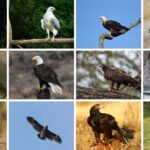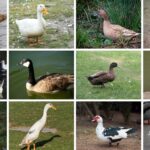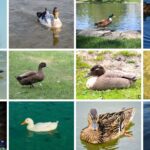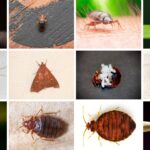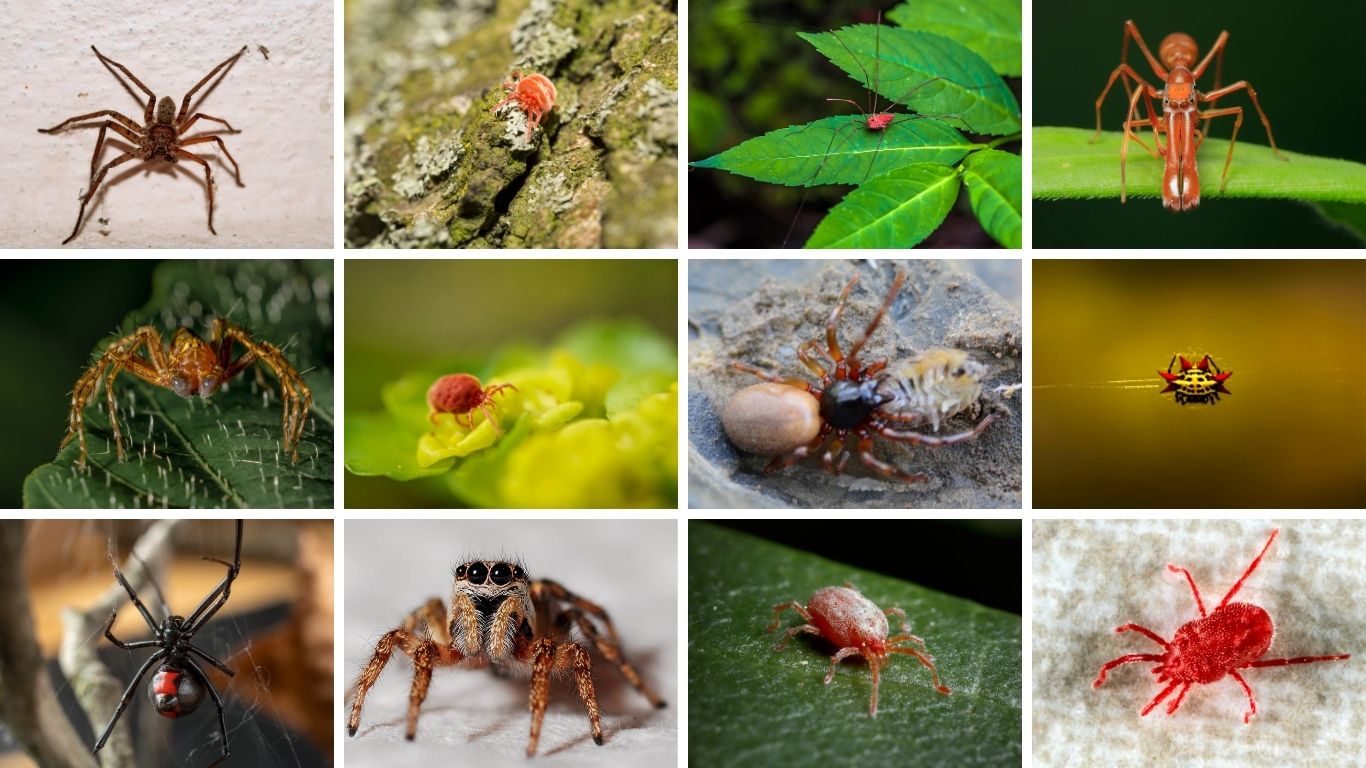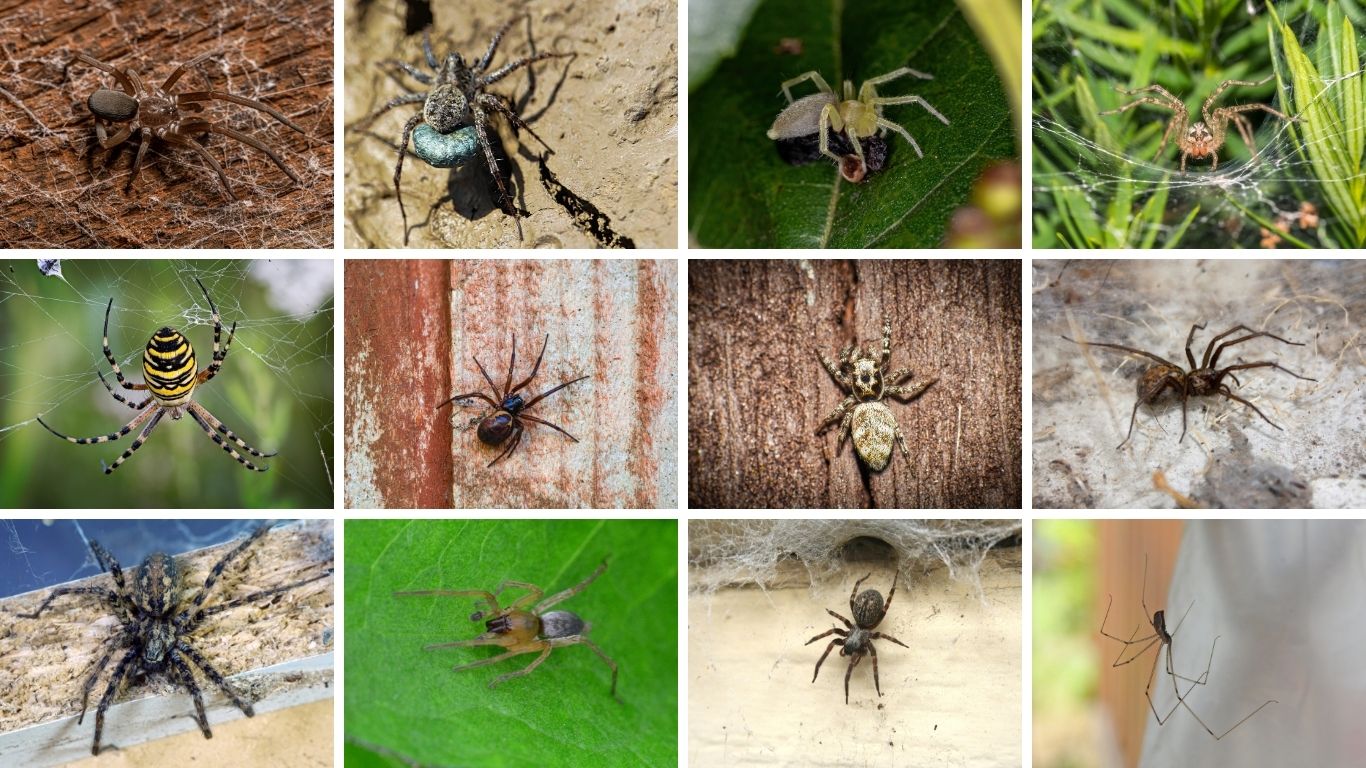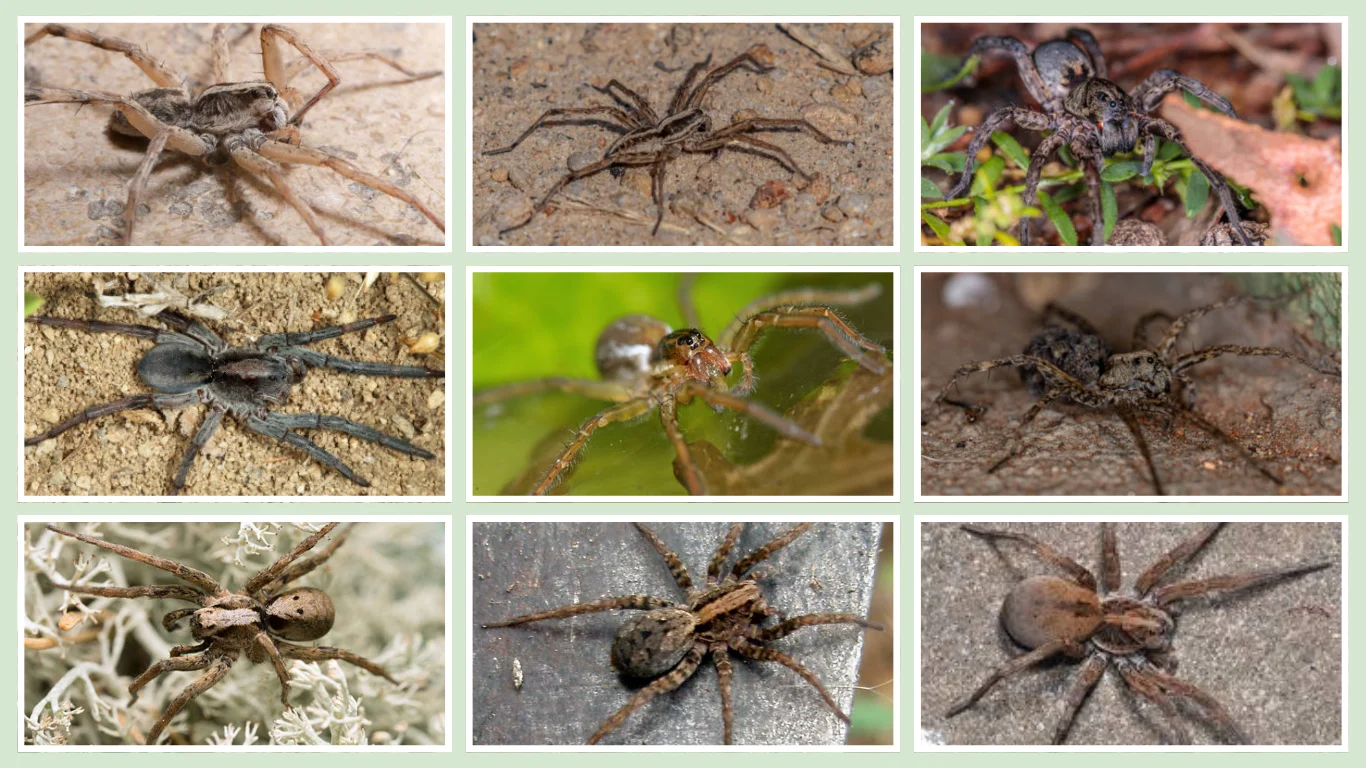Red spiders come in a fascinating variety of shapes, sizes, and patterns. Some stand out with bright red markings, while others are entirely crimson. From harmless hunters to venomous species, this guide explores 21 types of red spiders, including how to identify them, where they live, and what makes their red coloration so unique.
1. Red House Spider
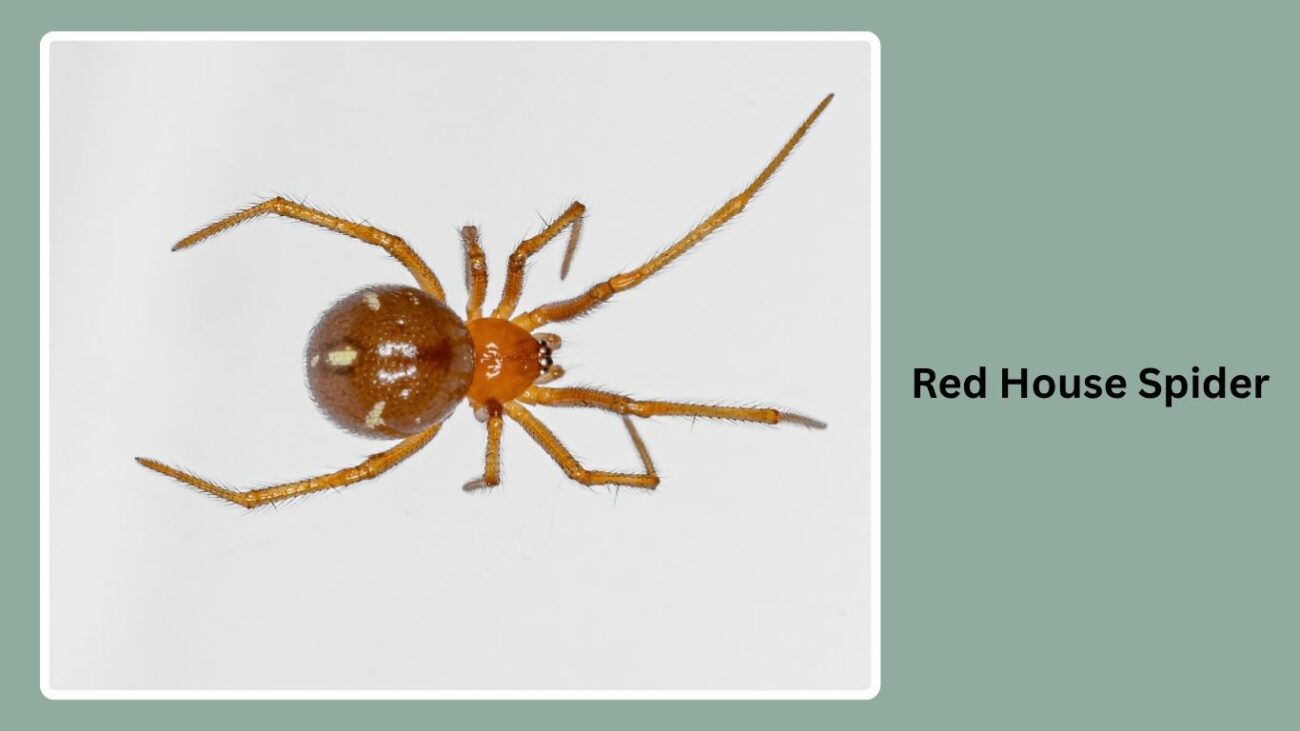
The Red House Spider is a common indoor arachnid known for its reddish-brown color and tendency to build tangled webs in corners, ceilings, and window frames. Though often mistaken for more dangerous spiders, it is mostly harmless to humans and plays a role in controlling small insect populations inside homes.
Identification
- Body color: Reddish-brown
- Size: 5 to 8 mm (females are larger)
- Abdomen: Round and bulbous
- Legs: Long and slender
- Web type: Irregular cobwebs
Habitat
Red House Spiders are frequently found indoors in undisturbed areas like closets, garages, basements, and behind furniture. Outdoors, they may hide under rocks, logs, or cracks in walls.
Behavior
These spiders are solitary and typically remain close to their web. They are not aggressive and only bite in self-defense, with mild symptoms if bitten.
Color Pattern
The spider’s overall hue ranges from reddish-orange to dark brown. The cephalothorax and legs are often darker, while the abdomen appears smoother and more reddish in tone.
2. Redback Spider
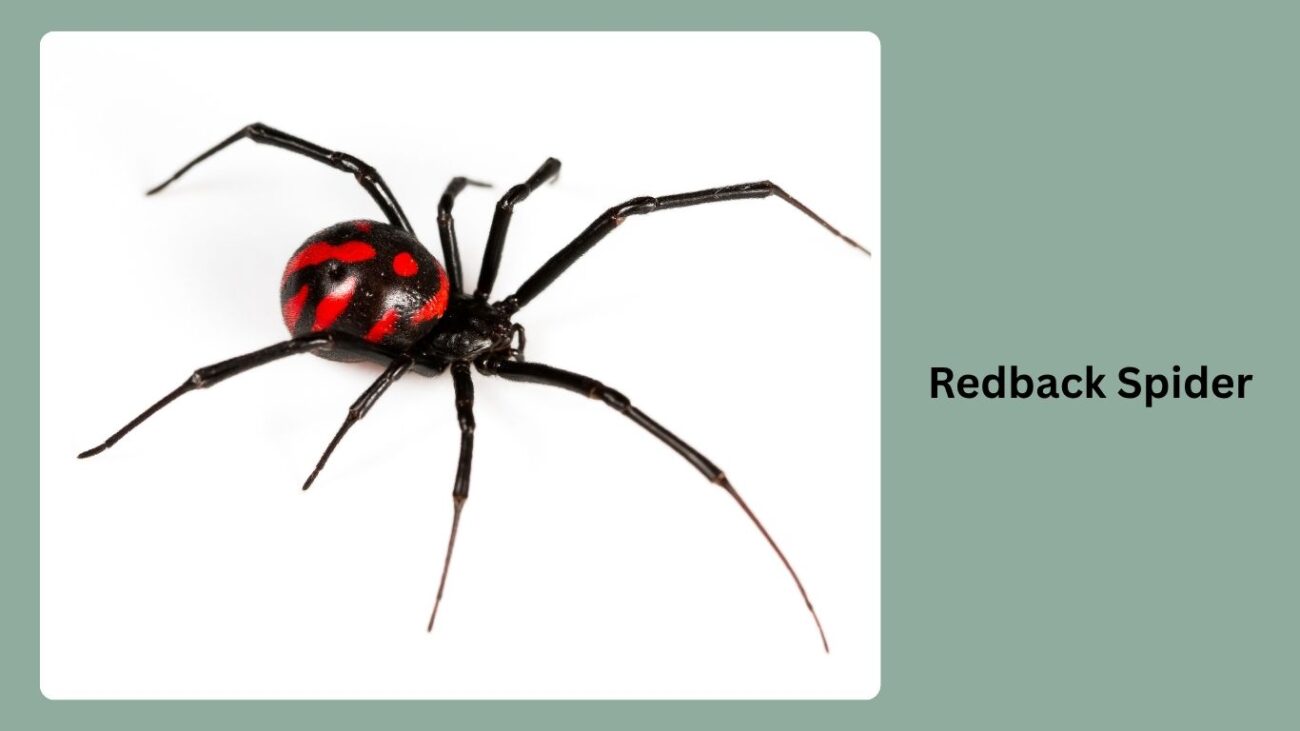
The Redback Spider is a venomous arachnid native to Australia, easily recognized by the distinctive red stripe on its back. It belongs to the widow spider family and is related to the Black Widow. Females are more noticeable due to their striking coloration and larger size.
Identification
- Body color: Glossy black with a bright red stripe
- Size: 1 cm (female), much smaller male
- Abdomen: Spherical with central red stripe
- Legs: Long and thin
- Web type: Irregular tangle web
Habitat
They prefer warm, sheltered locations such as sheds, mailboxes, under furniture, and outdoor toilets. They often inhabit dry areas in both urban and rural environments.
Behavior
Females rarely leave their webs and are known for their potent venom. They feed on insects and occasionally small lizards caught in their sticky silk traps.
Color Pattern
The female has a shiny black body with a bold, red stripe running along the top of the abdomen. Males are brownish with lighter markings and are less visible.
3. Red Widow Spider
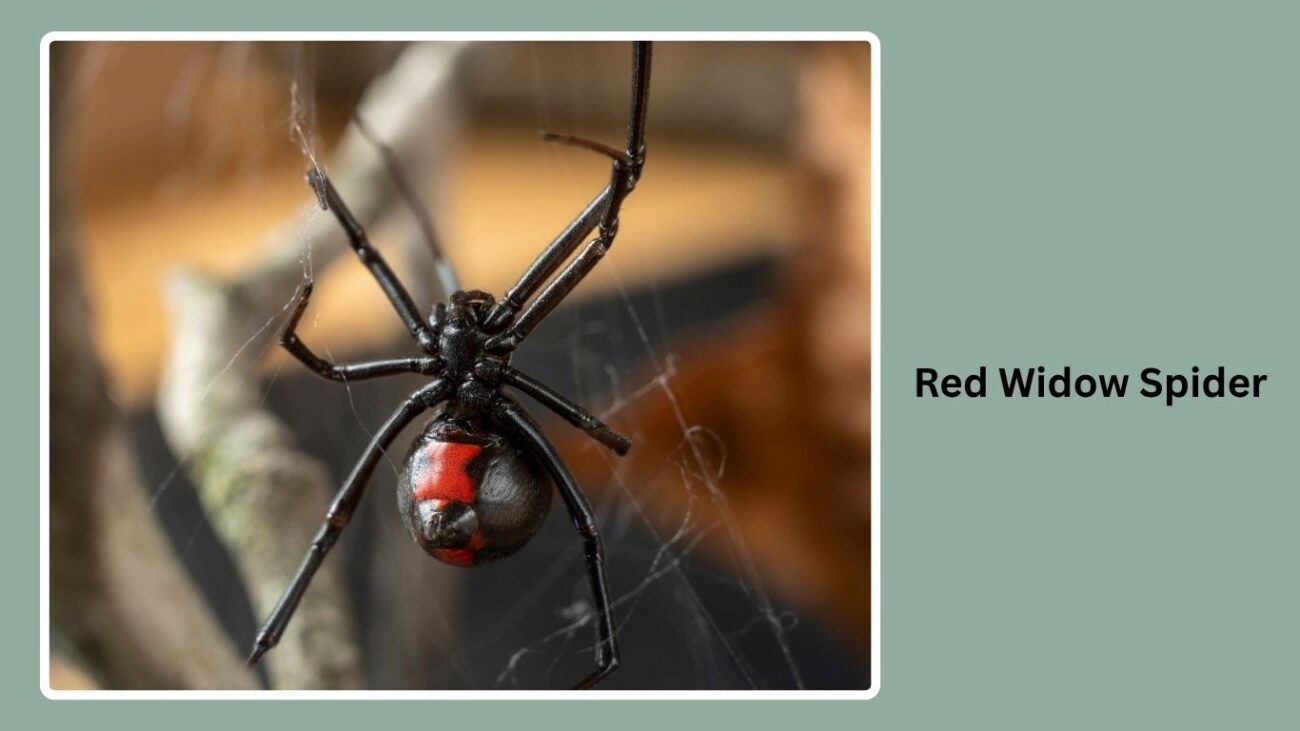
The Red Widow Spider is a rare and colorful species native to Florida. Closely related to the Black and Redback Widows, it is known for its reddish-orange legs and cephalothorax with a black abdomen bearing red or orange markings.
Identification
- Body color: Red cephalothorax and legs, black abdomen
- Size: Around 1.5 cm (female)
- Abdomen: Round, shiny with red/orange spots
- Legs: Long and reddish
- Web type: Irregular tangled web in palmetto scrub
Habitat
Red Widows live primarily in the sand dunes and palmetto scrub habitats of central and southeastern Florida. They are reclusive and rarely seen.
Behavior
These spiders are venomous and build their webs among palmetto leaves. They tend to avoid humans and bite only when provoked.
Color Pattern
Bright red-orange legs and head contrast sharply with a shiny black abdomen marked with red or orange spots or bands, making them one of the most vibrant widow spiders.
4. Red Jumping Spider
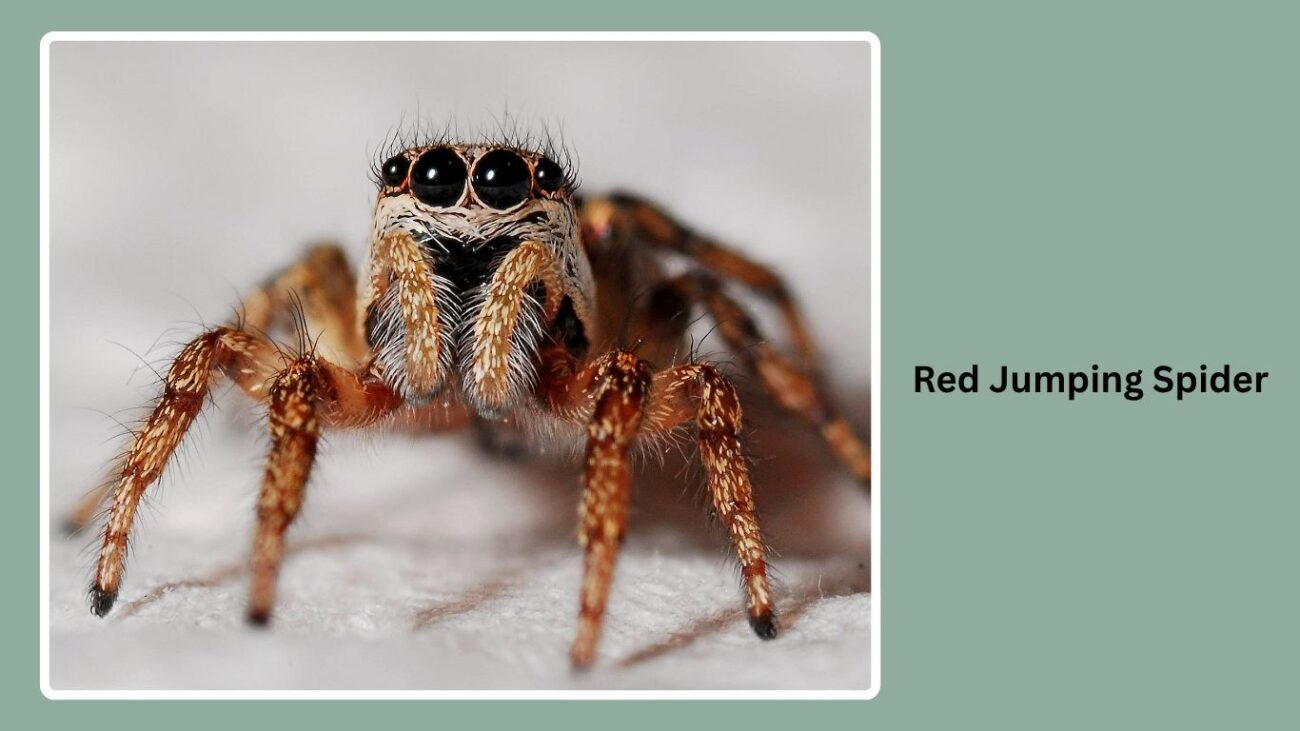
The Red Jumping Spider is a small but eye-catching spider known for its agile movements and brilliant red coloration. Unlike web-building spiders, it actively hunts its prey and relies on its excellent vision to track and pounce on insects.
Identification
- Body color: Bright red or reddish-orange
- Size: 6 to 10 mm
- Abdomen: Compact and slightly flattened
- Legs: Short, sturdy, and often hairy
- Web type: Does not spin typical webs – builds silk nests for shelter
Habitat
Often found on tree bark, fences, plants, and windowsills. They thrive in sunny, open areas where they can hunt.
Behavior
Active during the day, these spiders are curious and frequently turn to look when approached. They jump significant distances relative to their body size.
Color Pattern
Typically bright red all over or red with darker markings on the abdomen. Males sometimes display iridescent patches or black legs for mating displays.
5. Red Orb-Weaver Spider

The Red Orb-Weaver Spider is a member of the Araneidae family, known for its large, rounded abdomen and intricate wheel-shaped webs. These spiders are mostly nocturnal and help reduce garden pest populations.
Identification
- Body color: Bright red, reddish-brown, or rust-colored
- Size: 8 to 20 mm depending on the species
- Abdomen: Large and rounded with subtle patterns
- Legs: Spiny and long
- Web type: Large circular (orb) web
Habitat
They’re often spotted in gardens, forests, and shrublands, suspended in their webs between branches, tall grasses, or man-made structures.
Behavior
Red orb-weavers are passive hunters, waiting in or near their web’s center for prey to get trapped. They rebuild their webs regularly.
Color Pattern
Usually a deep red or reddish-brown with occasional markings or bands. Their legs may be striped or shaded darker at the joints.
6. Red-Spotted Ant Mimic Spider

The Red-Spotted Ant Mimic Spider is a clever impersonator that resembles ants in appearance and behavior. This mimicry helps it avoid predators and sometimes hunt ants by blending in with their colonies.
Identification
- Body color: Black with distinct red spots
- Size: 5 to 8 mm
- Abdomen: Elongated with central red patches
- Legs: Long and slender, front legs often raised like antennae
- Web type: No web; roams freely
Habitat
Found in gardens, forests, and under rocks or logs. Often seen walking among ant trails due to its mimicry behavior.
Behavior
Moves in a jerky, ant-like fashion to deceive both prey and predators. It may mimic ant scent and posture to infiltrate colonies.
Color Pattern
Mainly black with vivid red spots on the abdomen, especially near the rear. Some species also have reddish-brown legs or cephalothorax accents.
7. Red Velvet Spider
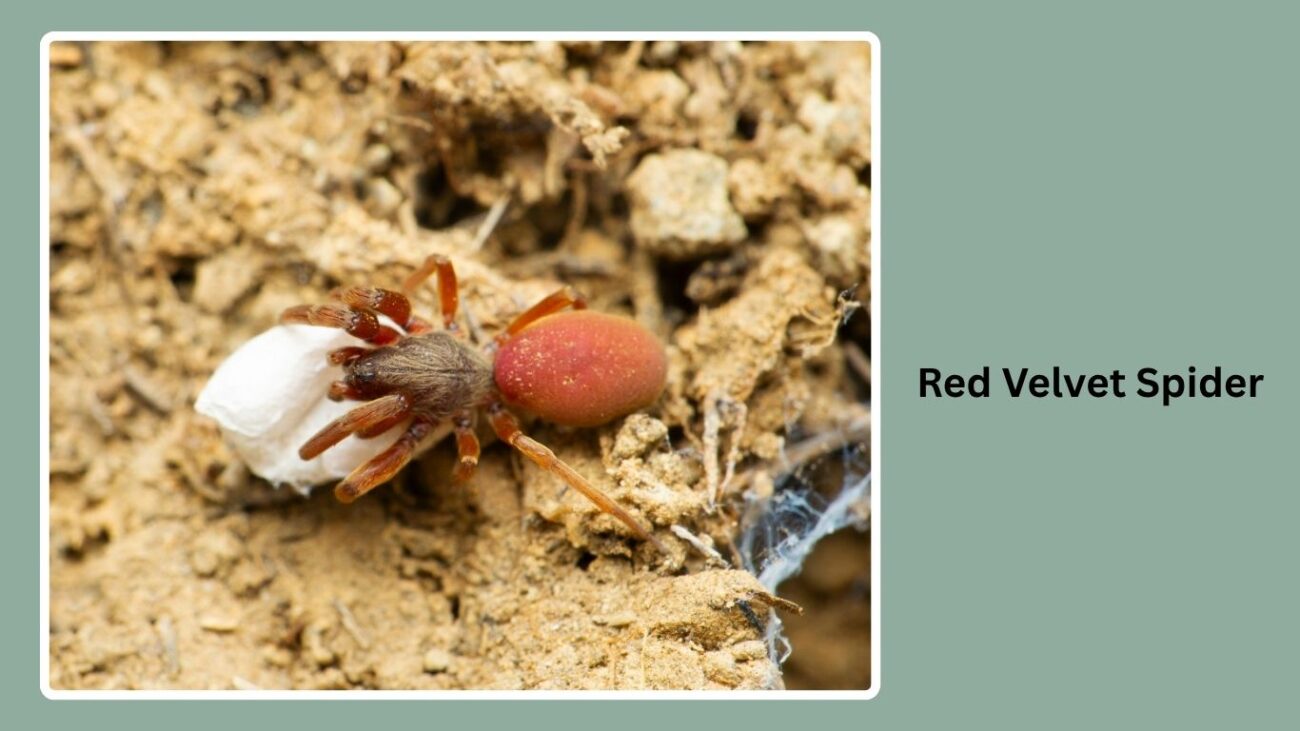
The Red Velvet Spider is a striking arachnid covered in dense, velvet-like red hairs. It belongs to the family Eresidae and is sometimes confused with velvet ants (which are actually wasps).
Identification
- Body color: Bright red body with black legs
- Size: 10 to 20 mm
- Abdomen: Oval and velvety
- Legs: Thick, black, and covered in short hairs
- Web type: Burrow silk-lined tunnels or hidden retreats
Habitat
Typically found in dry, arid regions, hiding in crevices, burrows, or under rocks. Rarely seen in populated areas.
Behavior
Solitary and ground-dwelling, they create silk retreats or dig shallow burrows. They’re not aggressive but will defend themselves if handled.
Color Pattern
The most distinctive feature is the velvety red body, which looks plush in appearance. Their legs contrast sharply in black, giving them a bold, two-tone look.
8. Red-Legged Purseweb Spider
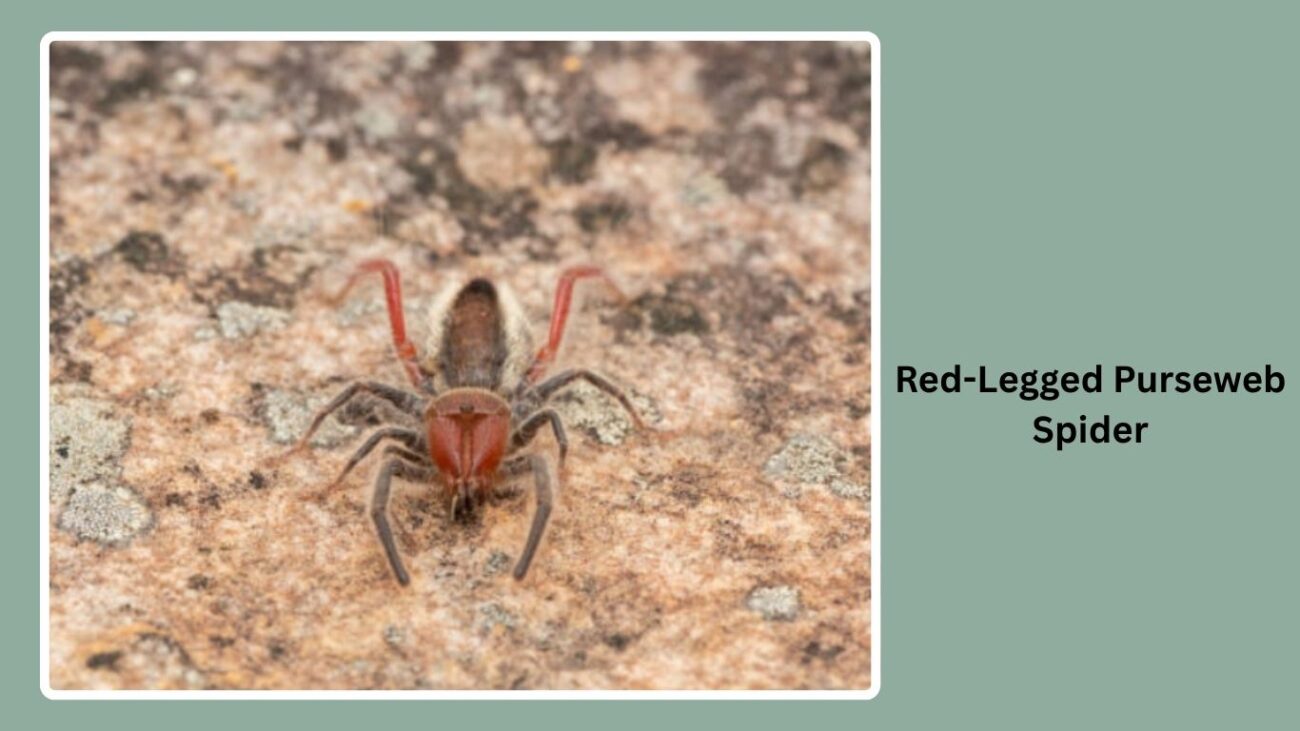
The Red-Legged Purseweb Spider is a secretive mygalomorph spider known for its underground silk tube homes and reddish legs. It belongs to the same infraorder as tarantulas and trapdoor spiders.
Identification
- Body color: Dark brown to black with red legs
- Size: 20 to 30 mm
- Abdomen: Cylindrical and smooth
- Legs: Reddish or burgundy, especially at the joints
- Web type: Vertical silk tube attached to the ground or tree base
Habitat
Found in forests, especially near the base of trees or under leaf litter. Prefers moist and shaded environments.
Behavior
It lives in silk tubes, waiting for prey to walk across the surface. It bites through the tube wall and drags the prey inside.
Color Pattern
Dark body contrasts with reddish or rusty red legs. The red coloration is often concentrated on the femurs and becomes darker toward the ends of the legs.
9. Red-Speckled Lynx Spider
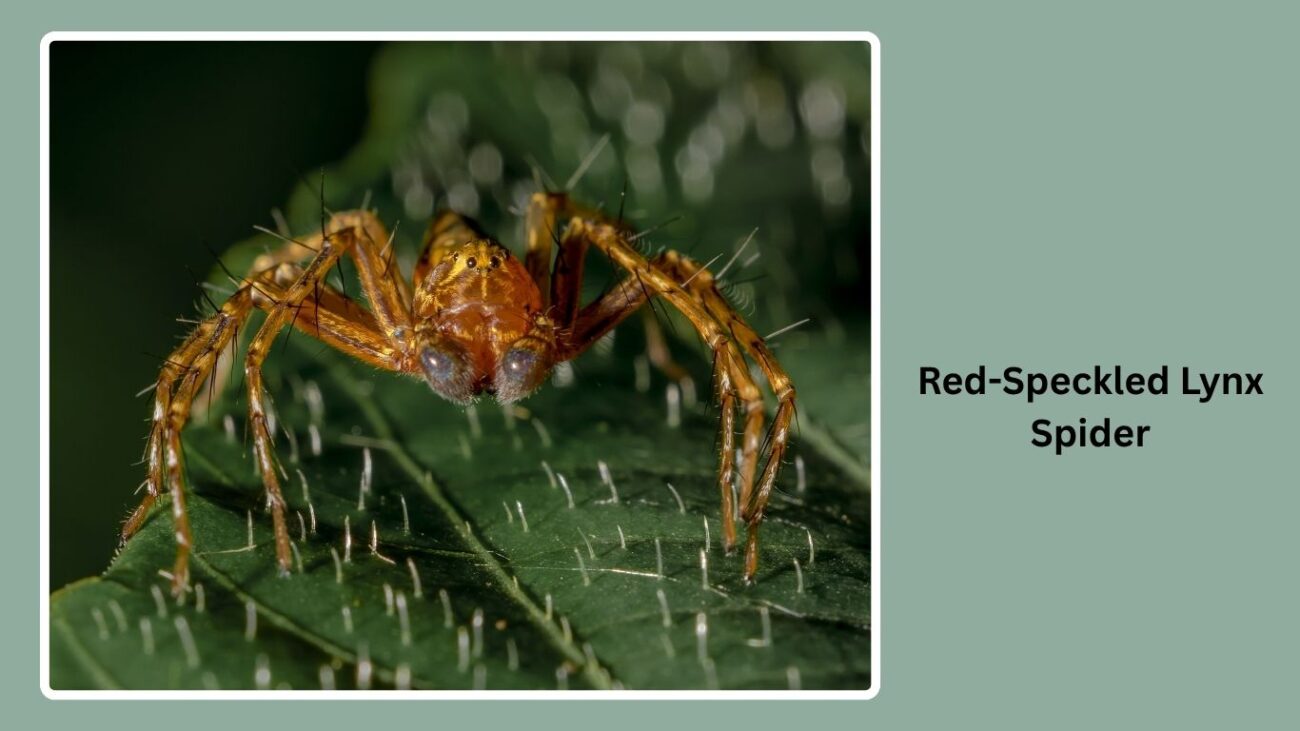
The Red-Speckled Lynx Spider is a visually stunning hunting spider recognized for its vibrant speckling and spiny legs. It doesn’t build webs to catch prey but uses its speed and agility.
Identification
- Body color: Pale green with red speckles
- Size: 10 to 15 mm
- Abdomen: Elongated with red or orange dots
- Legs: Long, translucent, and covered in spines
- Web type: No web; roams on vegetation
Habitat
Commonly seen on flowers, shrubs, and tall grasses in gardens and meadows. Prefers sunlit environments with good insect traffic.
Behavior
An active hunter that chases down its prey rather than using silk. It often rests in ambush positions among flower petals.
Color Pattern
Translucent green or pale body with vivid red speckles scattered across the abdomen and thorax. The legs may also show faint red or orange banding.
10. Red-Tailed Spider
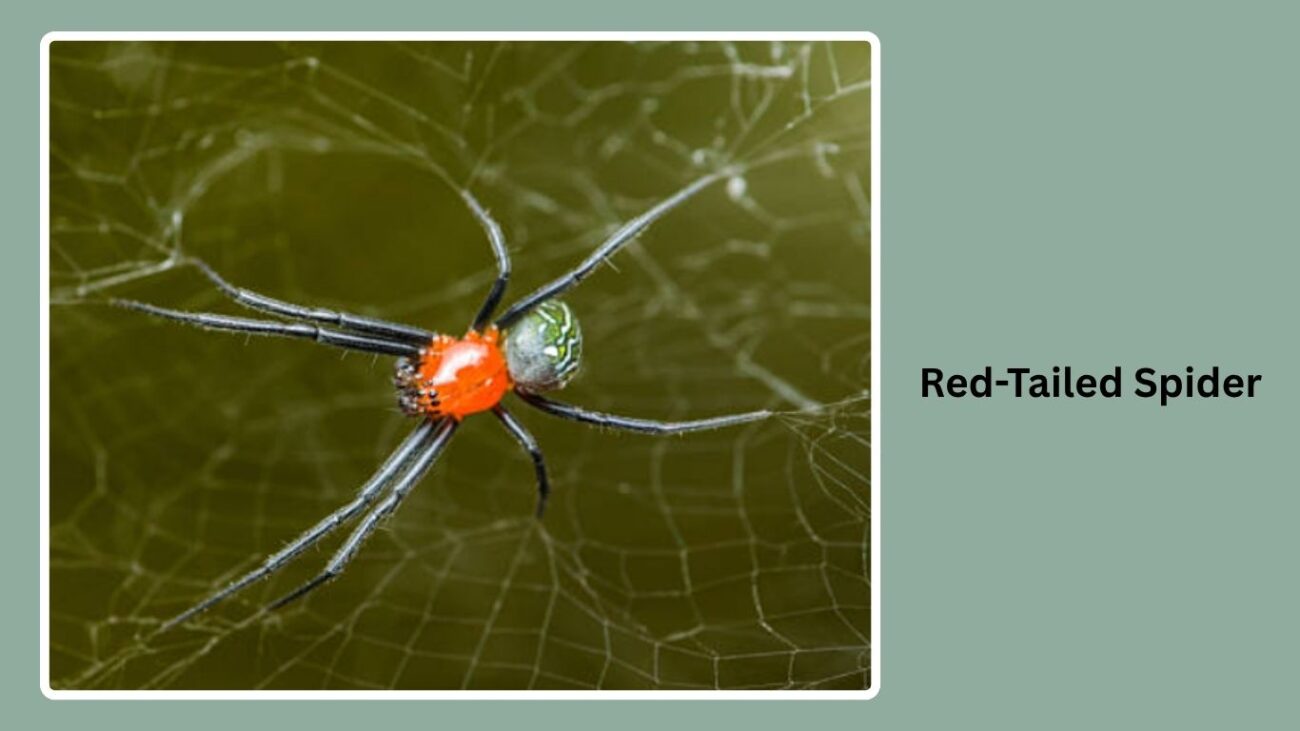
The Red-Tailed Spider is named for the distinctive reddish coloring on the rear part of its abdomen. This spider is a ground-dwelling hunter and often found in leaf litter or under stones.
Identification
- Body color: Brown to gray with red tail tip
- Size: 6 to 12 mm
- Abdomen: Slightly elongated with red at the end
- Legs: Short to medium length, often the same color as the body
- Web type: Does not build traditional webs
Habitat
Usually found in forests, gardens, or fields, especially in shaded or damp areas. Hides under logs, rocks, or in crevices.
Behavior
Prefers to ambush prey rather than chase it. It stays low to the ground and uses camouflage to remain unnoticed.
Color Pattern
The main body is neutral-toned, such as brown or gray, while the tip of the abdomen is marked with a bright or rusty red patch, giving it the “red-tailed” name.
11. Red-Striped Spider

The Red-Striped Spider is easily recognized by the vivid red stripes running along its body. This spider often dwells among grasses or shrubs and blends well with its surroundings.
Identification
- Body color: Light brown or tan with red stripes
- Size: 5 to 10 mm
- Abdomen: Slim with longitudinal red lines
- Legs: Long and matching the body color
- Web type: Light, messy web or no web at all
Habitat
Common in grassy fields, gardens, and low vegetation. They can also be found on tree bark or building surfaces.
Behavior
These spiders are shy and move quickly when disturbed. They may spin light silk as draglines or retreats but rarely spin catch webs.
Color Pattern
Features thin or bold red stripes running lengthwise along the abdomen and sometimes the cephalothorax. The red contrasts against the light brown or tan body background.
12. Red-Cheeked Spider
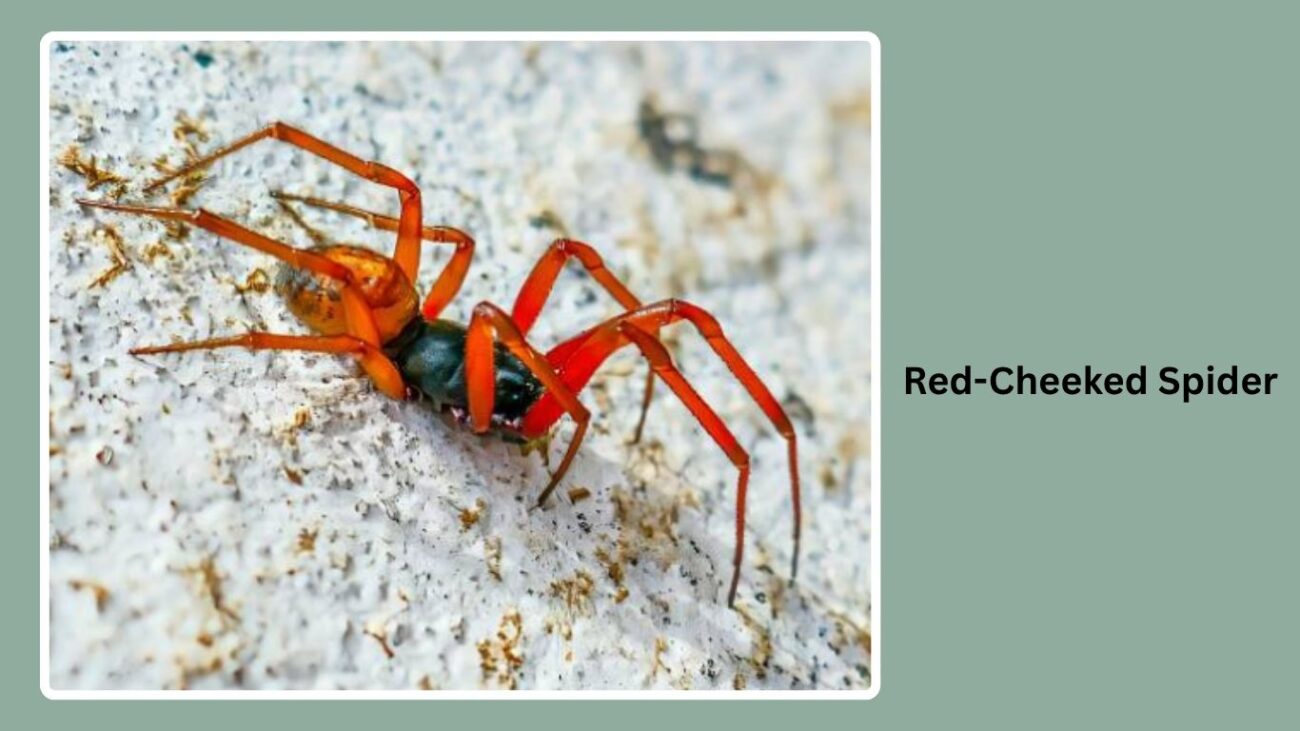
The Red-Cheeked Spider is known for its unique reddish markings on either side of its face, resembling flushed cheeks. Though not commonly encountered, it’s a visually distinctive species that often lives in vegetation.
Identification
- Body color: Gray or brown with red facial spots
- Size: 6 to 9 mm
- Abdomen: Oval-shaped, usually plain
- Legs: Slender, matching the body tone
- Web type: Sparse silk or none
Habitat
Found in shrubs, low branches, and occasionally on garden plants. Prefers quiet, leafy environments with limited human disturbance.
Behavior
Often rests motionless during the day, relying on camouflage. It hunts small insects and may use a silk retreat for hiding.
Color Pattern
The most defining feature is the pair of red or orange markings on the sides of the cephalothorax, giving the appearance of red cheeks. The rest of the body is typically neutral-toned.
13. Red-Headed Mouse Spider

The Red-Headed Mouse Spider is a burrowing mygalomorph known for its deep red head and powerful fangs. It is native to Australia and is considered one of the more venomous mouse spider species.
Identification
- Body color: Glossy black abdomen, bright red head and jaws
- Size: 10 to 35 mm (females larger)
- Abdomen: Round and shiny black
- Legs: Thick and strong, black
- Web type: Silk-lined burrows with trapdoor
Habitat
Found in dry, sandy environments across Australia. Lives in burrows which may be up to 30 cm deep.
Behavior
Rarely aggressive but can bite if provoked. Females stay in burrows, while males wander in search of mates.
Color Pattern
Deep red or maroon head and cephalothorax contrast sharply with the jet-black abdomen and legs, making this spider easy to recognize.
14. Red-Femured Trapdoor Spider
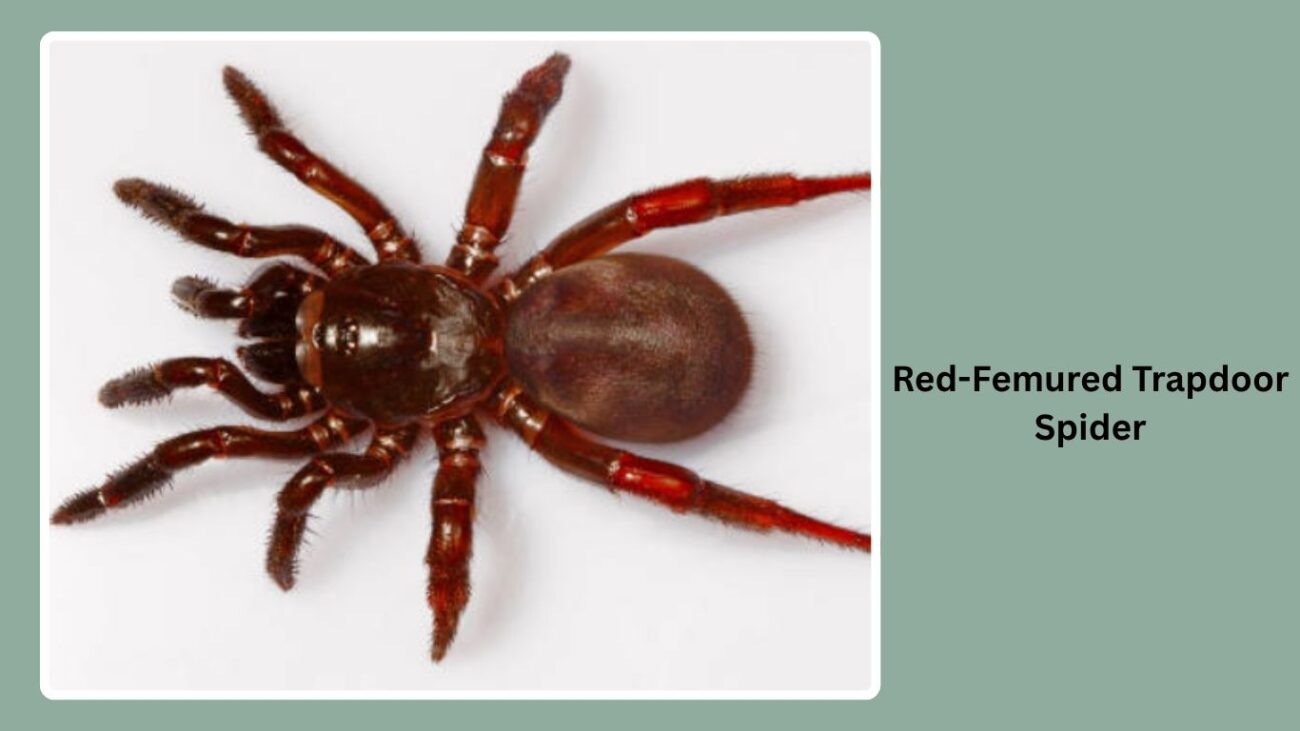
The Red-Femured Trapdoor Spider is a robust, ground-dwelling spider known for its powerful legs with noticeable red coloring on the femurs. It constructs burrows with camouflaged trapdoors to ambush prey.
Identification
- Body color: Dark brown to black with reddish femurs
- Size: 20 to 30 mm
- Abdomen: Thick and slightly hairy
- Legs: Strong, red on the femurs, dark below
- Web type: Silk-lined burrow with trapdoor lid
Habitat
Prefers forest floors, dry scrublands, or moist soils. Found under logs, rocks, or leaf litter, always near a concealed burrow.
Behavior
Stays hidden during the day and hunts from the safety of its trapdoor at night. It lunges at prey that walks past the burrow entrance.
Color Pattern
Dark overall with distinct rusty red or maroon coloring on the upper legs (femurs). This bold red contrasts against the spider’s otherwise dull appearance.
15. Red-Bellied Spider
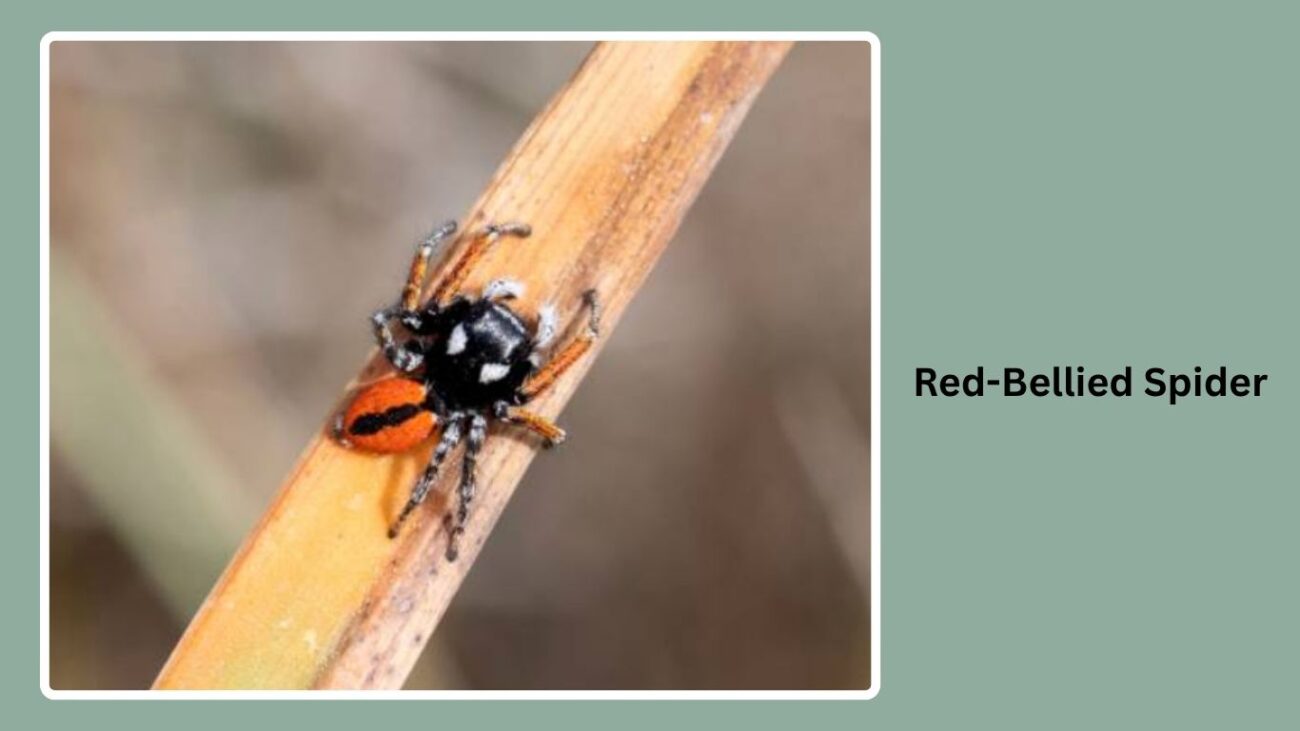
The Red-Bellied Spider is named for the vivid red coloration on the underside of its abdomen. Though small and inconspicuous from above, the red belly serves as a warning to potential predators.
Identification
- Body color: Black or dark brown with red underside
- Size: 5 to 8 mm
- Abdomen: Oval, black above, red below
- Legs: Slender and dark
- Web type: Irregular web or none
Habitat
Found in gardens, forest edges, and under rocks or logs. They may take shelter in leaf litter or crevices.
Behavior
Shy and reclusive, they prefer to avoid confrontation. If threatened, they may display their red underside as a deterrent.
Color Pattern
Dark topside helps with camouflage, while the bright red belly is revealed when the spider feels threatened, often accompanied by a defensive posture.
16. Red-Kneed Tarantula
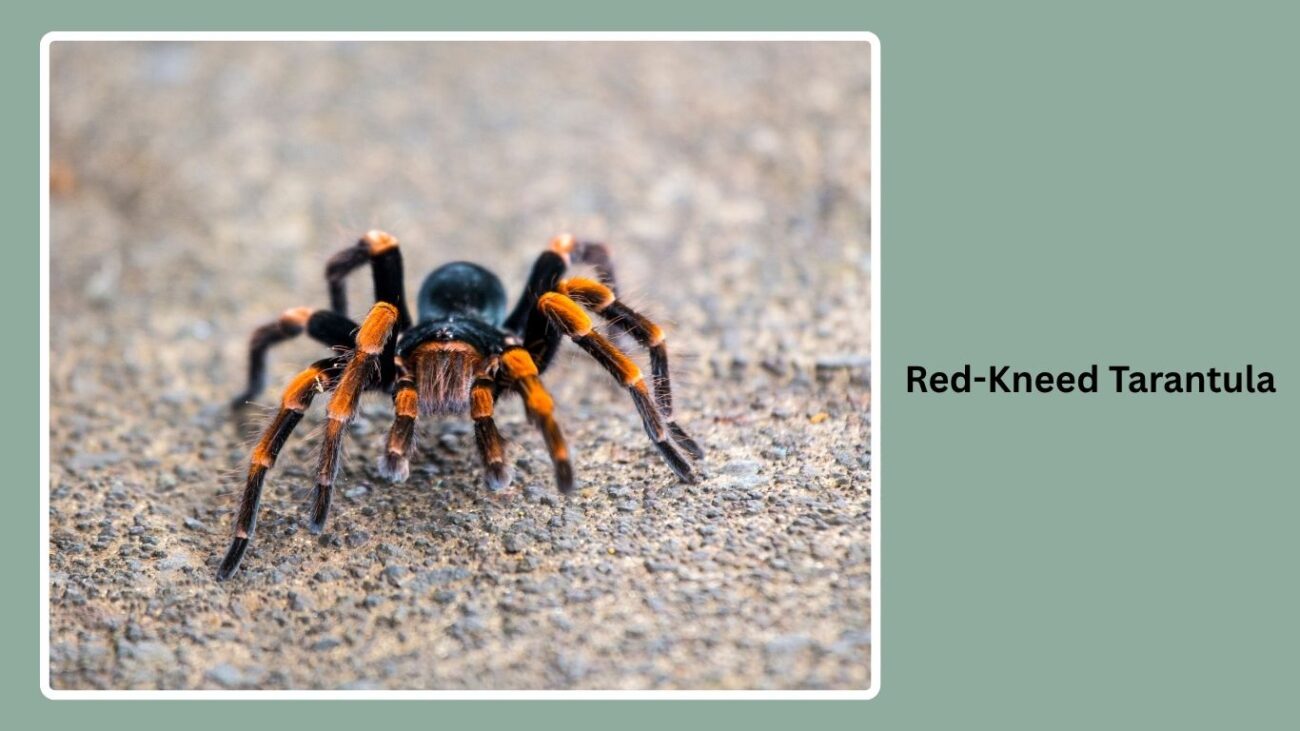
The Red-Kneed Tarantula is a large and visually striking species known for the reddish-orange coloration around its leg joints. Native to Mexico, it’s a popular tarantula in the exotic pet trade due to its calm temperament and bold coloring.
Identification
- Body color: Black with red or orange on leg joints
- Size: 12 to 15 cm leg span
- Abdomen: Large, rounded, and hairy
- Legs: Thick, black with red-orange bands on knees
- Web type: Ground burrows with silk lining
Habitat
Inhabits dry, arid environments such as deserts and scrublands. It creates silk-lined burrows for shelter and hunting.
Behavior
Generally docile and slow-moving. When threatened, it may flick urticating hairs from its abdomen or rear up in a defensive posture.
Color Pattern
Black body with striking red or orange patches on the “knees” (femur-tibia joints). The contrast between the black and red makes this tarantula highly recognizable.
17. Red-Banded Tunnel-Web Spider
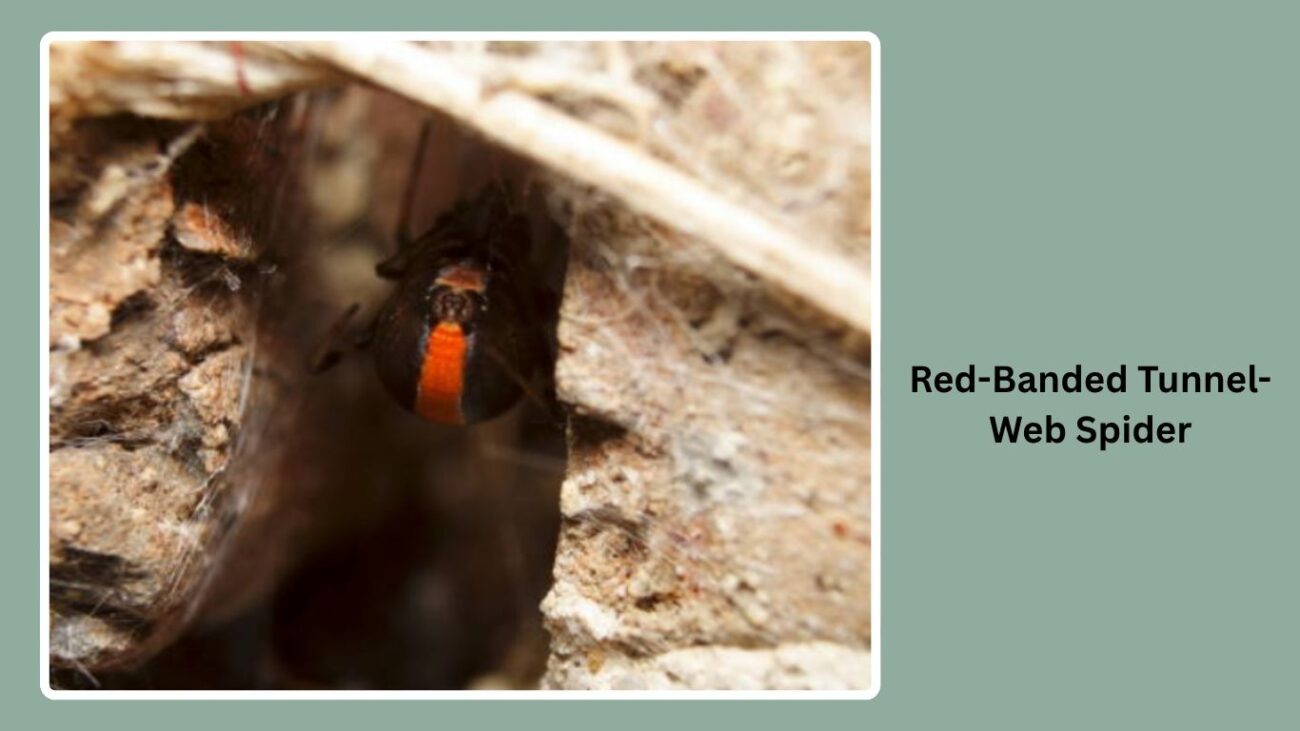
The Red-Banded Tunnel-Web Spider is a secretive and robust species that lives in silk-lined tunnels and is known for the reddish bands around its legs. It is a close relative of the funnel-web spider family.
Identification
- Body color: Dark brown or black with red leg bands
- Size: 25 to 35 mm
- Abdomen: Thick, oval, dark-colored
- Legs: Powerful with red bands at joints
- Web type: Silk tunnel with a retreat area
Habitat
Found in forest floors, under rocks, and in decaying logs. Prefers damp and shaded environments with loose soil for digging.
Behavior
A reclusive ambush predator that waits in its tunnel until prey approaches. It strikes quickly and drags the prey inside.
Color Pattern
Dark overall, with reddish bands circling the leg joints. These red markings are especially visible when the spider is in motion or during defensive displays.
18. Red-Footed Spider
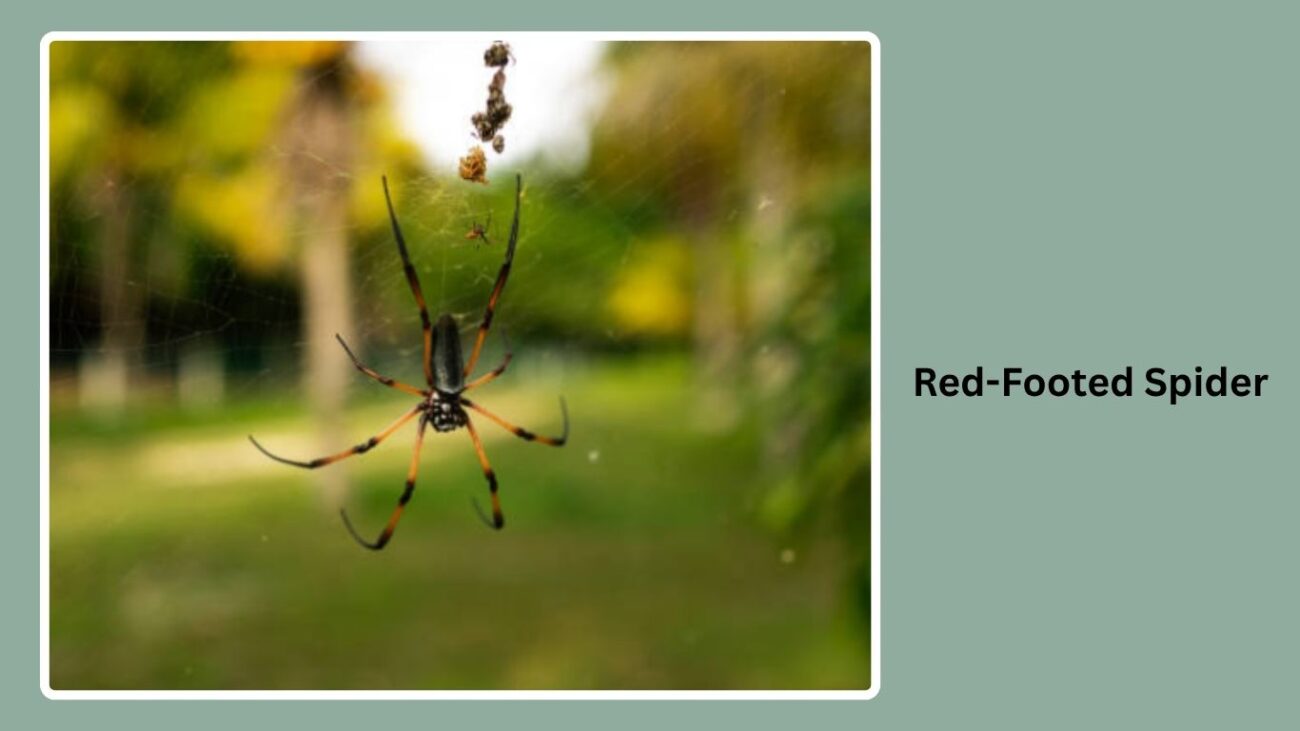
The Red-Footed Spider gets its name from the reddish or rusty coloration on the tips of its legs. Though not very large, its distinctive coloring makes it stand out among leaf litter and vegetation.
Identification
- Body color: Brown or gray with red-tinted feet
- Size: 6 to 10 mm
- Abdomen: Oval and slightly patterned
- Legs: Slender, red coloring at the feet (tarsi)
- Web type: Minimal silk used; no web for hunting
Habitat
Typically found on the forest floor, in gardens, or under rocks and logs. Prefers shaded, humid areas with plenty of cover.
Behavior
An active ground hunter that doesn’t rely on webs. Moves swiftly to capture insects and often retreats into small holes or debris piles.
Color Pattern
The body is earthy in tone, helping it blend with surroundings, but the bright red feet serve as subtle visual markers and may act as a warning or camouflage enhancement.
19. Red-Backed Jumping Spider
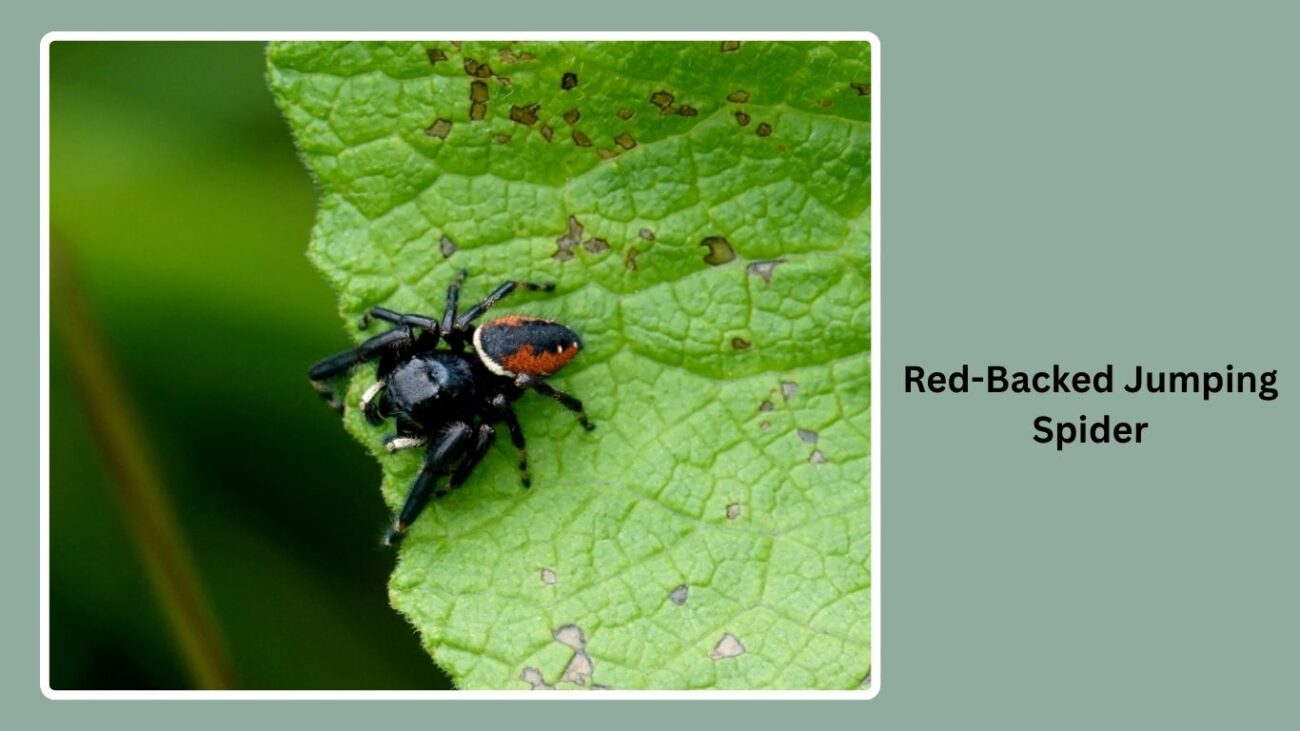
The Red-Backed Jumping Spider is a small, energetic species that features a vivid red patch across its back. It belongs to the Salticidae family and is often seen darting around plants and walls.
Identification
- Body color: Black with a bright red stripe or patch on the back
- Size: 5 to 8 mm
- Abdomen: Flattened and compact with red marking
- Legs: Short and robust, usually dark-colored
- Web type: No capture web; uses silk for safety lines
Habitat
Found in gardens, tree bark, fences, and walls. Prefers sunny locations where it can easily hunt small insects.
Behavior
Highly visual and agile hunters. They stalk prey and leap onto it with precision. Known for being curious and even turning to face observers.
Color Pattern
Jet-black body with a prominent red or orange stripe across the top of the abdomen. The red marking varies from a full stripe to a bold oval patch.
20. Red-Faced Huntsman Spider
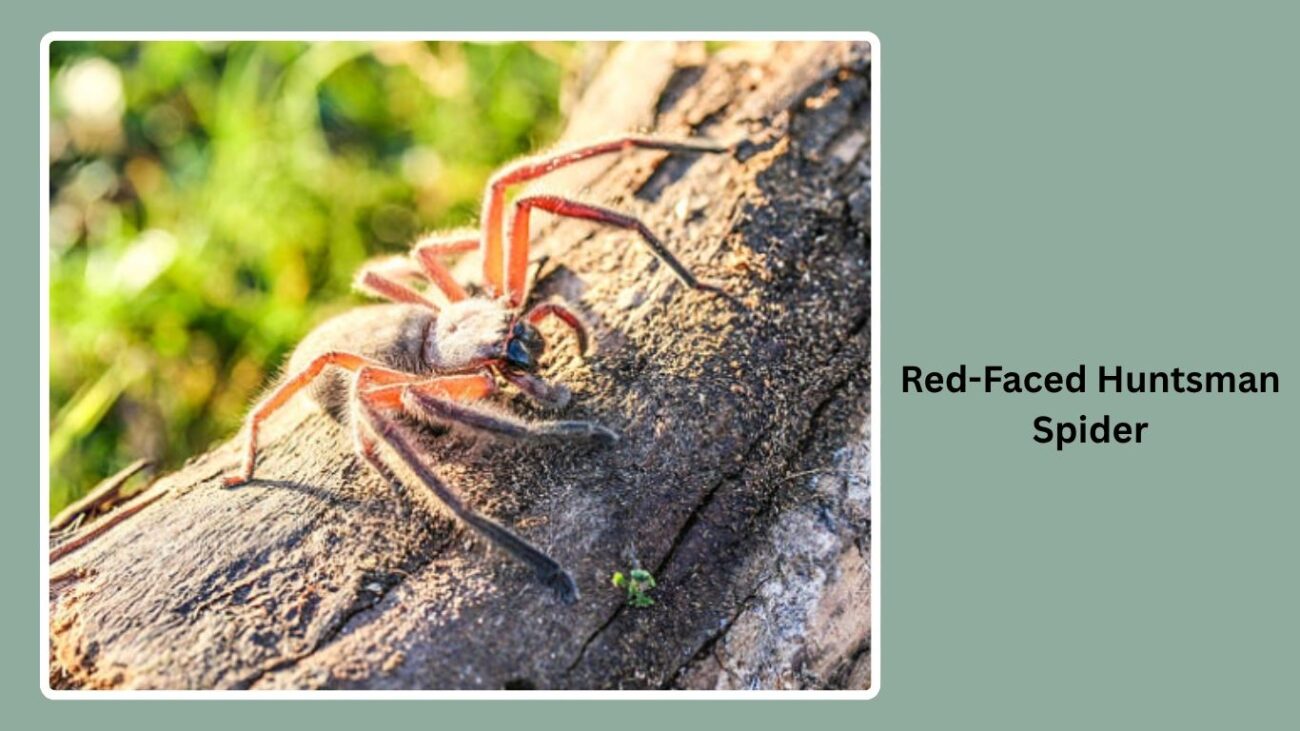
The Red-Faced Huntsman Spider is a large, fast-moving spider known for its reddish face and wide, flat body. Though intimidating in size, it is not aggressive and is often found in homes or natural shelters.
Identification
- Body color: Gray or brown with a reddish face
- Size: 15 to 30 mm (body length)
- Abdomen: Flattened and oval
- Legs: Long and extended sideways
- Web type: Does not build webs; uses shelters
Habitat
Commonly found under bark, rocks, in sheds, or even indoors. Prefers warm environments and natural crevices to rest.
Behavior
Nocturnal and fast-moving, it actively hunts for insects rather than using webs. It flattens its body to hide in tight spots.
Color Pattern
Generally neutral-toned with a vivid red or rusty-red cephalothorax (face region). The rest of the body blends with surroundings, while the red face adds a striking contrast.
21. Red-Spined Spider
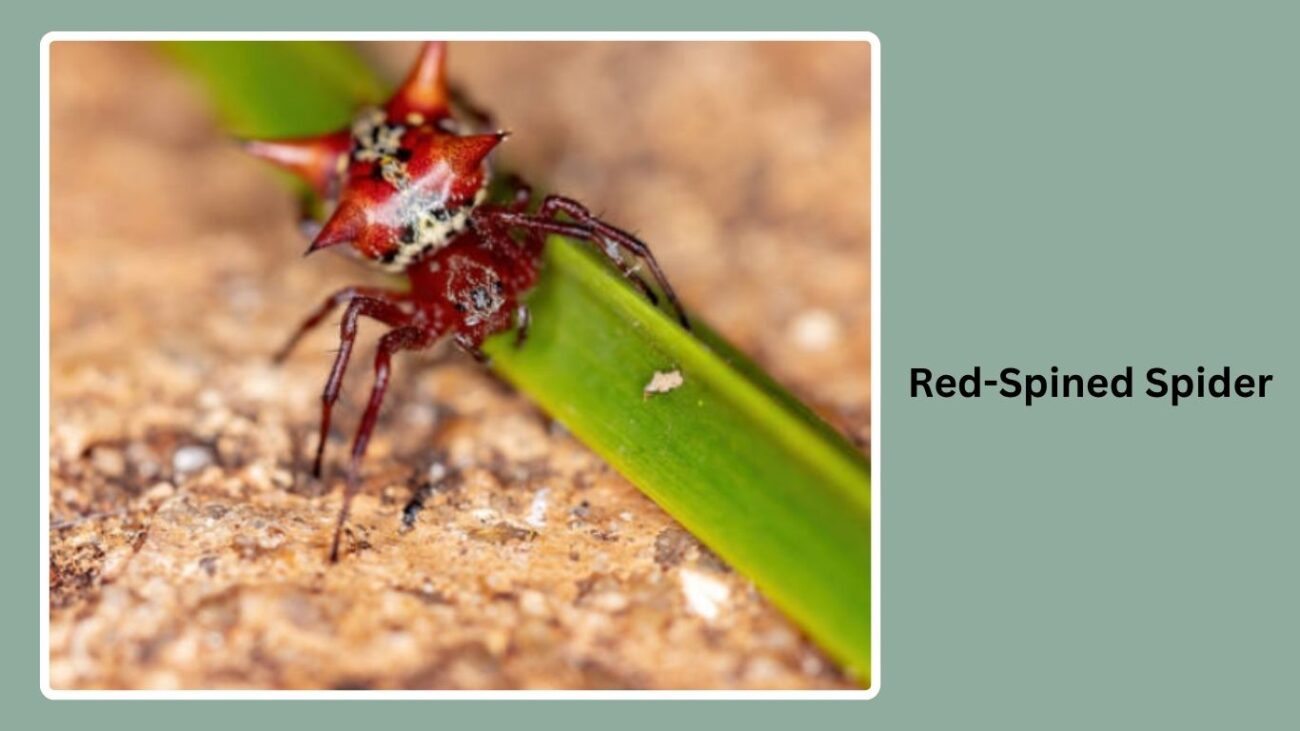
The Red-Spined Spider is a unique and spiky-looking orb-weaver that features bright red spines protruding from its abdomen. It’s a striking species both in structure and color.
Identification
- Body color: White or pale base with red spines
- Size: 5 to 9 mm
- Abdomen: Wide, flat with sharp, red projections
- Legs: Shorter and darker
- Web type: Circular orb web
Habitat
Found in gardens, forests, and shrubbery. Builds webs between branches or man-made structures.
Behavior
Constructs classic orb webs and waits patiently in the center. Non-aggressive and retreats when disturbed.
Color Pattern
Typically features a white or yellowish abdomen with multiple bright red spines or ridges along the edges. The red protrusions give it a star-like or crab-like appearance.
FAQs
Are red spiders dangerous to humans?
Most red spiders are harmless to humans. However, a few species like the Redback Spider and Red Widow Spider are venomous and should be avoided. In general, red coloration in spiders may serve as a warning signal, but not all red spiders pose a threat.
Why are some spiders red in color?
Red coloration in spiders can serve various purposes, including camouflage, mating displays, and warning coloration to deter predators. It may also help them blend into specific environments like flowers or red-toned foliage.
Can I keep red spiders as pets?
Yes, certain red spiders like the Red-Kneed Tarantula are popular in the exotic pet trade. However, proper care, habitat setup, and legal considerations should be researched before keeping any spider as a pet.
Where are red spiders commonly found?
Red spiders can be found worldwide, from deserts and forests to gardens and inside homes. Their habitats vary widely depending on the species — some burrow in the ground while others build webs in shrubs or corners of buildings.
What should I do if I get bitten by a red spider?
Most red spider bites are not medically significant. Clean the bite area and monitor for swelling or pain. If symptoms worsen, especially after a bite from a known venomous species like the Redback Spider, seek medical attention immediately.


